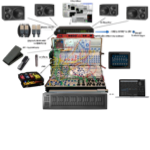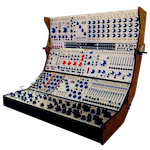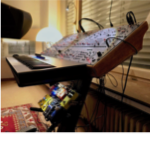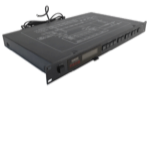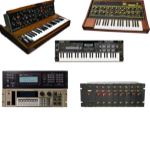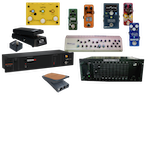ARP Instruments
The name ARP is the abbreviation of Alan R. Pearlman (1925-2019), the founder and genius of the company, that existed only from 1969 to 1981. Alan Pearlman had founded the company together with Lewis G. Pollock, a lawyer, and David Friend, a young " whiz kid" and engineer (whom Pollock had discovered in Princeton), to dedicate himself to research and development - he had previously built amplifiers and technical equipment for NASA's Gemini and Apollo programs.
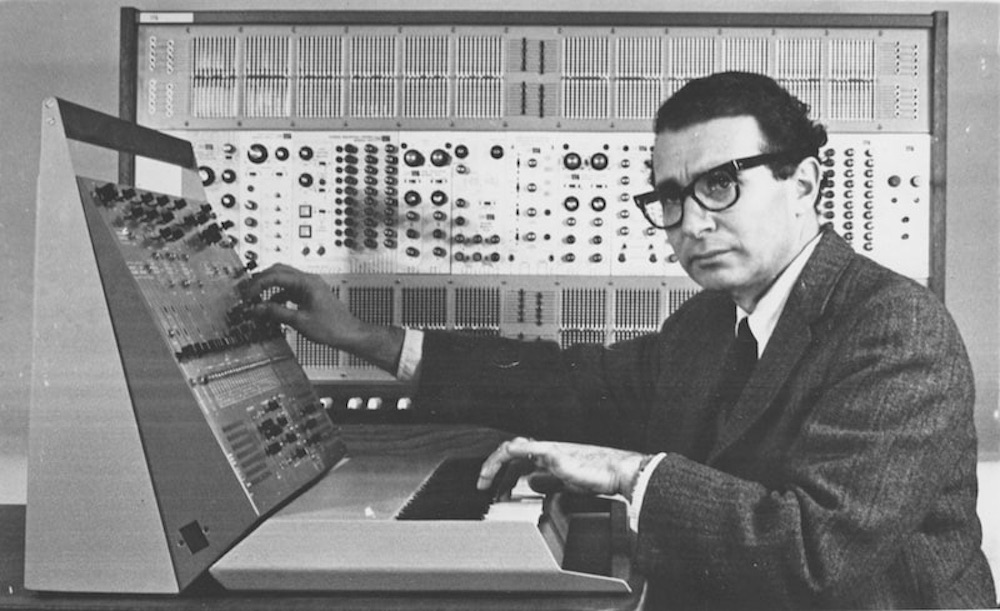
Disastrous management and the overall difficult situation caused the demise of the relatively small company in 1981 - even though ARP had dominated the international synthesizer market since the mid 70's and Alan R. Pearlman had done everything right.
The ARPs in my Life
2500 | 2600 | Odyssey | Axxe | Little Brother | Rhodes Chroma
The first ARP (1970) was the ARP 2500. Sadly, I never owned this instrument, yet it had an enormous impact on my life. The first record with synthesizer that really caught me, at that time a budding jazz pianist, was "Scorpio" by Paul Bley - who played piano, electric piano and an ARP 2500 on that record. I was infected right away as the record had just been released.
ARP 2500
The synthesizers that began to appear in the mid-1960s were huge, heavy, expensive, and they needed patch cords - which were especially unpopular with live musicians. In addition, the oscillators were previously not pitch stabile - "live" this was a killer problem".
The ARP 2500 was therefore, technically speaking, a real statement: a voice-stable modular synthesizer - with matrix sliders instead of patch cables.
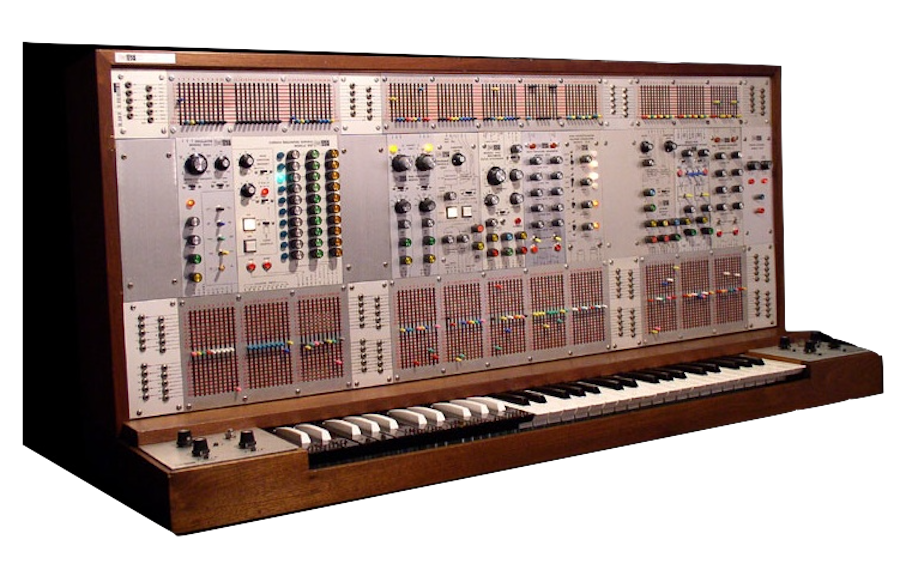
 The various parameters were color-coded to make it easier to identify the affiliation. A known shortcoming was that the matrix sliders suffered from crosstalk issues. I guess it was the first synthesizer that featured a multimode filter. While the 2500 alone was already quite large - it could even be extended by "Wings" (cabinets)!
The various parameters were color-coded to make it easier to identify the affiliation. A known shortcoming was that the matrix sliders suffered from crosstalk issues. I guess it was the first synthesizer that featured a multimode filter. While the 2500 alone was already quite large - it could even be extended by "Wings" (cabinets)!
However the ARP 2500 could also be smaller (below). This model, which is at home in the Experimental Studio of SWR, is the only 2500 I have ever come across. But it is not 100% ARP, because it was modified / extended by Peter Lawo.
The 2500 is less known from the stage but from the recordings of The Who, Jimmy Page, David Bowie, Jean Michel Jarre, Vangelis, Kraftwerk, Elton John and others. It is also frequently heard in experimental tape music of the 70s and, of course, in many movies of that time. Most famous, without question, is Steven Spielberg's science fiction epic 'Close Encounters of the Third Kind', in which the ARP 2500 has a major appearance (even if the 5-note sequence could have been played with some simpler synth). The man playing the 2500 to communicate with the UFOs was Phil Dodds - then ARP's vice president of engineering. The ARP 2500 has a, to this day, very distinctive sound and is one of the grand "classics". I think there were only a little over 100 instruments built of it.
The ARP 2500 was available from $10.000 to $20.000. One dollar was about DM 3.50 and an average monthly income was about DM 1200. So the smallest model of an ARP 2500 (including transport and taxes) was the equivalent of three and the big system of six years' salary! For non-industrial people simply unaffordable. This is the well worth seeing ARP 2500 Brochure, approx. from 1973.
ARP 2600
The ARP 2600 (built 1971-81) is a semi-modular synthesizer with 3 VCOs and it has an operating voltage of 15V.
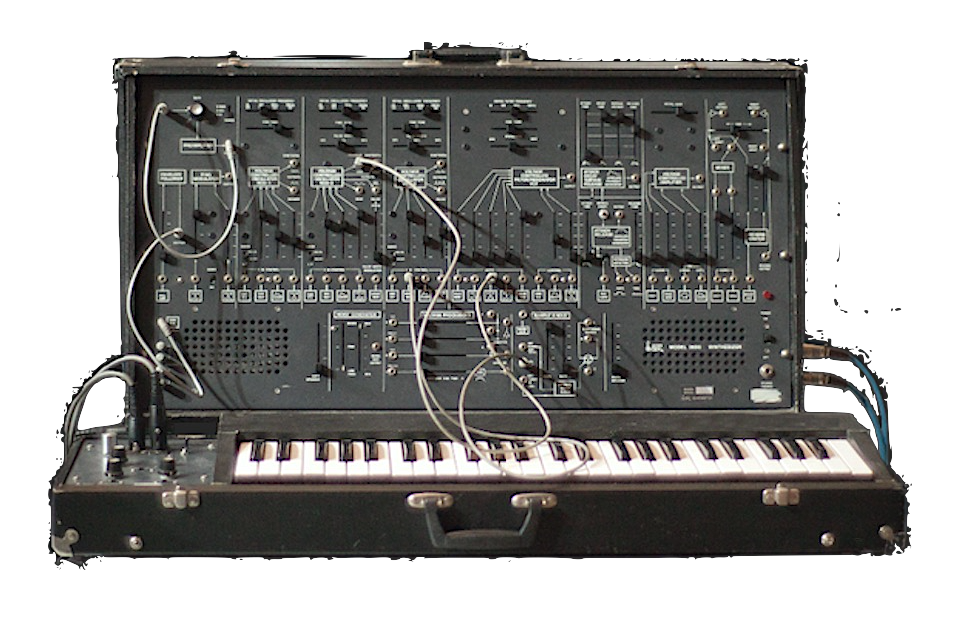
The modules (assemblies) are internally pre-wired. Therefore the 2600 can be played without patchcables - and is called a "semi-modular“. An inserted patch cable disconnects the pre-cabling at that point and the use of patch cables can result in quite complex circuits and sounds. The ARP 2600 was also used as a teaching tool in many schools in the USA, thus its level of popularity almost corresponds to that of the Mini Moog.
It has to be mentioned that the first, very rare models of the 2600 had a different look and take a unique position already because of their pet names "2600 Blue Marvin" (approx. 25 pieces, individually handmade) and "2600 Gray Meanie" (approx. 35 pieces, produced a bit more organized, handmade according to production scheme). Unfortunately, the series of the ARP 2600 shown in the picture were successively equipped with parts of inferior quality (VCOs, OpAmps, power supply, spring reverb) from the very beginning, due to financial reasons. This was also evident in the higher noise floor. The VCOs used later did not sound as great, but the originally used Teledyne VCOs simply were too expensive.
Technically, this can be corrected or improved today, but the original ARP 2600, regardless of the series, has become a very, very expensive instrument (overpriced). Furthermore, spare parts (e.g. sliders) have reached the end of stock and you may have to move to modern spare parts alternatives, i.e. you can no longer maintain the "original technical condition". Therefore, before buying an original, one should check if it is "only" a matter of obsession and I recommend to definitely consult an experienced ARP technician (like Eric van Baaren / Saint Eric). Neither knowledge, nor an overview or networking of this species, which is also becoming increasingly rare, can be achieved off the cuff.
This instrument was a "heavyweight" in the most compact packaging to date. The choice of the assemblies (modules) shows proof of wisdom and makes the instrument quite "complete". The layout is so well arranged ( also by using sliders) that even beginners in electronics have a chance to understand it pretty soon. It can be heard on countless records and in just as many movies. Nearly everyone should know R2D2, the robot from Star Wars, for example. Joe Zawinul played two ARP 2600 in his band "Weather Report" over many years, so that the 2600 was a distinctive part of the characteristic sound of that band. With its three VCOs, it was a (far more powerful) MiniMoog parallel, but never was considered to be that because of the patch cables. As a more offensive competitor to the Mini, ARP brought the Odyssey one year later, which, however, only had two VCOs - but could be expanded by an "external input" with a third VCO, delivered by the ARP Little Brother.
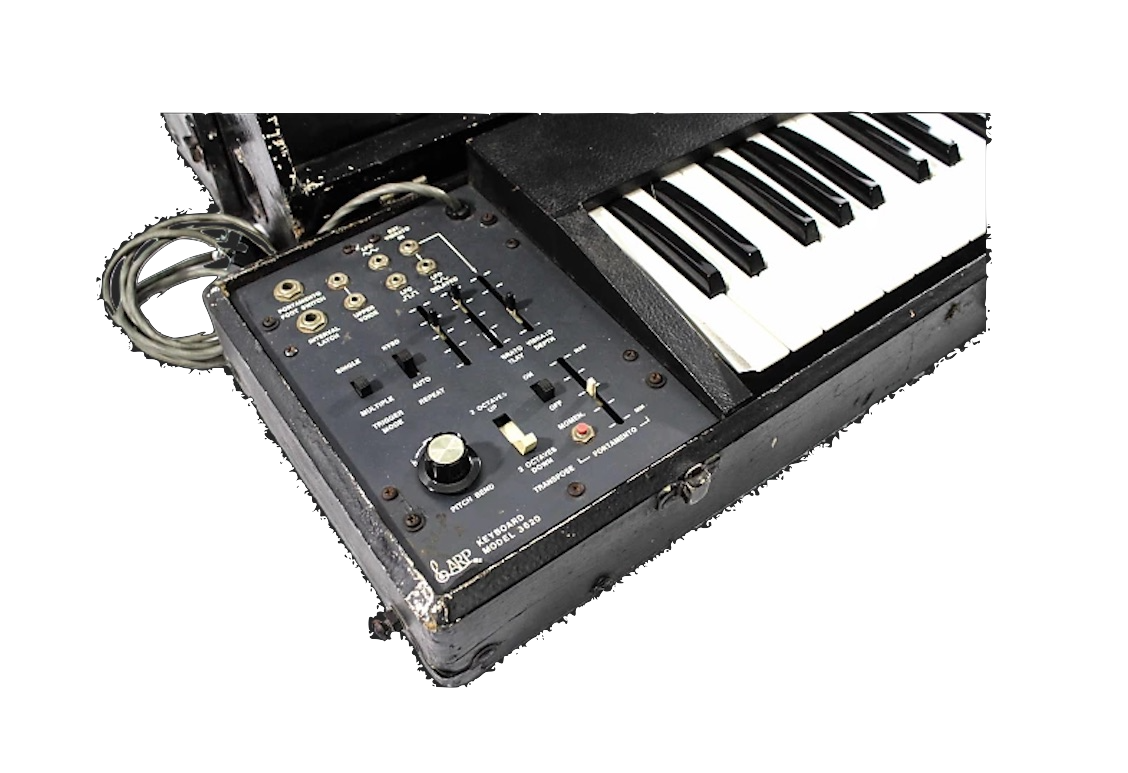 Over time, there were three different keyboard models for the ARP 2600, all of them "Pratt Read" keyboards, with only the last model 3620 (small photo) being duophonic. This made the "big case" two-voiced. Furthermore an additional LFO and a momentary portamento switch was now "at hand".
Over time, there were three different keyboard models for the ARP 2600, all of them "Pratt Read" keyboards, with only the last model 3620 (small photo) being duophonic. This made the "big case" two-voiced. Furthermore an additional LFO and a momentary portamento switch was now "at hand".
My 2600 was an early model and I rarely ever got to play with the 3620 and the difference from monophonic to duophonic was huge! Quite different things were of course possible. The LFO was not just an "additional" LFO - it made the 2600 a synth with 3 VCOs, because one VCO no longer needed to be the LFO.
The ARP 2600 was, after the Rhodes Chroma, my second synth. I was keen on a 2600 because I thought (and still think) that Patrick Gleeson's playing, especially on the LP "Realization" by Eddie Henderson, was the best approach for playing synths in a jazz context (and of course Paul Bley on "Scorpio"). Having all parameters accessible via sliders was sensational! I owned the ARP 2600 for about 12 years and used it a lot "live" - often without keyboard - until the early 90s. At that time I didn't really know how synthesizers function technically: everything was trial and error.
 When the ARP 2600 was released in 1971, the format was of course incredibly portable. Before that, there were bands who had synths on their records - and piano and organ on stage, because neither the instrument itself nor the logistically complicated transport could be funded. This situation led to the "stage synthesizers", which were good for different "melody sounds", but had almost nothing in common with the complexity of a modular synth. The 2600 was therefore groundbreaking - also in the range of its application areas: from school to studios to world stars on stage - and, like a stage synth, it could be played without any patch cord - and still offered more! The ARP 2600 is without doubt one of the most fascinating synthesizers ever built!
When the ARP 2600 was released in 1971, the format was of course incredibly portable. Before that, there were bands who had synths on their records - and piano and organ on stage, because neither the instrument itself nor the logistically complicated transport could be funded. This situation led to the "stage synthesizers", which were good for different "melody sounds", but had almost nothing in common with the complexity of a modular synth. The 2600 was therefore groundbreaking - also in the range of its application areas: from school to studios to world stars on stage - and, like a stage synth, it could be played without any patch cord - and still offered more! The ARP 2600 is without doubt one of the most fascinating synthesizers ever built!
From today's point of view it is hardly comprehensible, but the ARP 2600 was so unpopular during the early 80s that I purchased my instrument for just DM 180 (today € 90.-) - and it actually was one of the "good" early grey ARPs - which I wasn't aware of at that time! People in the early 80s were particularly disgusted by patchcords - they felt it was totally outdated (and they were looking for polyphony primarily). The fact that the misperception of the extremely potent ARP 2600 lasted almost until the new millennium was due to the rapid progress of DSP (Digital Signal Processing) - but also to the fact that there were practically no technicians who could or would service or fix these synths - and it happened to be before the internet. Meanwhile it has turned into the contrary. The new 2600s by KORG and especially by Behringer will probably change the situation and only the well-preserved or collectible ARP 2600s will remain that expensive.
The particularly beautiful and instructive ARP 2600 Manual:
ARP ODYSSEY 2811
& ARP Little Brother
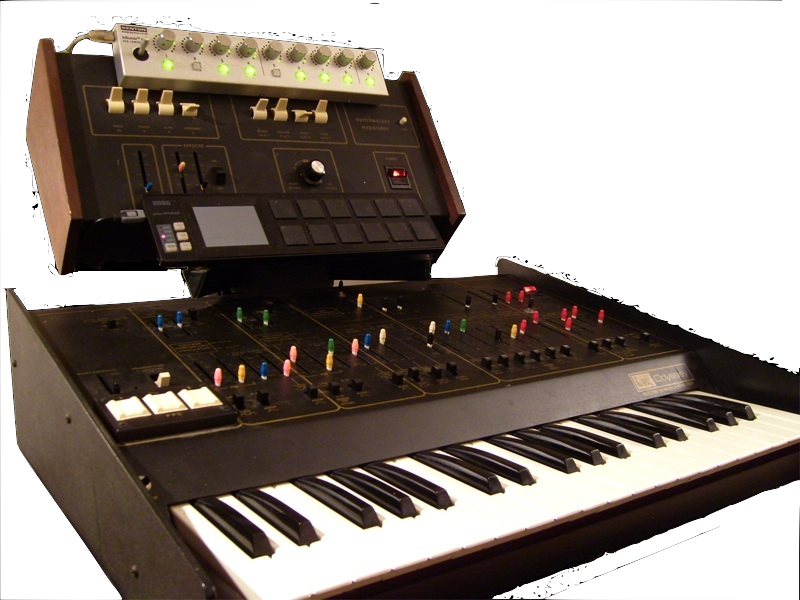
Excerpt of a live performance I played on the pictured instrument (and MAX) in 2009:
The setup also included two pedals (Volume and Expression) and a Portamento switch (using a sustain pedal). The Kenton KillaMix and the Korg Nano Pad (both MIDI controllers) served for controlling my Max patches.
The Odyssey (1972-81) was finally embraced by those musicians who felt overwhelmed by the parameter richness of the ARP 2600. The lower price certainly helped as well. Eventually, the Odyssey and 2600 were both seen as competitors to the Mini Moog.
With the Odyssey, we again encounter two technical ideas from the ARP 2500: color coding and switches (instead of the matrix sliders) that replace the patch cables. Their alignment in a row between the keyboard and the sliders makes the switching operations clearly arranged and very quick.
The material of the bottom tray (U-shaped with side parts) is vinyl. A wonderful material: it feels much better / "warmer" than metal. It remained my favorite Odyssey setup, although three more Odysseys have followed. This Ody had three mods: 1. LFO Speed (/10, normal, *10), 2. Duophony-Switch and 3. Envelope-Speed Switch (/10, normal, *10).
The ARP Odyssey 2811 was my choice when my "second synthesizer age" entered a more in-depth phase in 2006. ARP provided exactly the sound I had been looking for a long time in combination with Max/MSP - these were exactly the "lost" sounds (after 25 years of digitalization)! Now this small, 35 year old stage synthesizer was suddenly extremely appealing. It was supported by its "Little Brother" (see below: ARP Little Brother).
The min-max values (absolute pop averages) of the Envelopes and the LFO were absolutely unsatisfactory for me, as was the generally "worn out" technical condition of the instruments, which were already more than 30 years old at that time. This circumstance brought me to Eric van Baaren (SaintEric.eu), who repaired and modified my instruments. I quickly realized that these instruments - thanks to Eric's interventions - were better suited for me than ever, because he customized them perfectly for my needs! From Eric I also got the pictured (and rare) ARP Little Brother (see below) - with a VCO of the ARP 2600. But most of all I also got an extensive ARP education because of SaintEric. Only now I got to know the instruments properly - before I had played them merely without a clue.
The sound of the Odyssey is not as powerful as that of the ARP 2600. Unfortunately, the VCA's are the shortcoming of the Odyssey - and I assume that the difference is also due to the fact that the 2600 runs on 15V and the Odyssey on 12V. The keyboard of the 2811 was better than the keyboard of the later Odyssey series. Better weighted, smooth and almost noiseless.
Odyssey Patches and Tutorial (1973)
There was a booklet and a music cassette "PERFORM!" with an introduction to the Odyssey by Roger Powell. I have merged both into one video:
ARP ODYSSEY 2821 and ARP ODYSSEY 2823
I got an never been used Odyssey 2821 (black / orange) back in 2009. It had been purchased in 1976 and wrapped under foil. A phantastic unit - nevertheless all the contacts and sliders (many of them immovable) needed to be cleaned, and some capacitors to be replaced. The Odyssey was gradually changing roles in my setup, and became a synth-within-a-synth with the acquisition of the MOTM Modular Synth (in 2010). While more complex things took place on the Modular Synth, the Odyssey - due to its interface - was there for "fast actions".
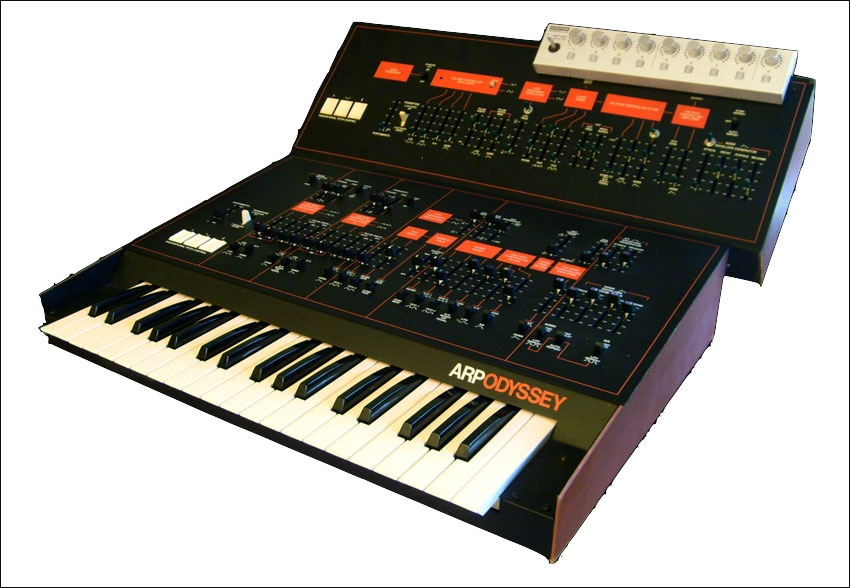
To this Odyssey 2821 I had "as third and fourth VCO" an Axxe MkII (see the photo), that I had transformed into an expander, of course having Eric's help. Intriguing, but not as convincing as the Little Brother. It was a visual delight, but generally I didn't get comfortable with the (all) metal Odyssey. Although everything was crisper on all three black / orange models that I had at that time, I was already troubled by the look (I felt yelled at by the orange) and the feel (cold and edgy).
It all started with me requesting a second instrument in response to the fragility of the 2811 (black / gold). I also had purchased a Odyssey 2823 from the USA in addition (which pleased me sonically again but it was equipped with an even worse keyboard than on the 2821) - all of them had a different sound, even those from the same series, as Eric and I could determine during a great comparison in his workshop. I learned that the components can have 10% and sometimes up to 20% deviations.
Subsequently, the great conversion started. Filters, VCA, all kinds of things were swapped with each other or against other components and now it became even more fascinating: the individual components also sounded different in the individual instruments! So it was practically impossible to make two instruments sound the same. I enjoyed the instruments in reverse order to their condition. The most worn out Ody remained to be the best, even after replacing the (best) Filter with a worse one (of the same type) it kept its character!
Thus, it depends on the art of the technician, the available components and the fortune of having components that also harmonize with the rest of the instrument. The appearance is another matter... and, to be clear: all these instruments sounded and behaved differently - but they all sounded great.
The Odyssey runs on 12V operating voltage.
The ARP Odyssey Series
Model 2810-2813 (1972-78)
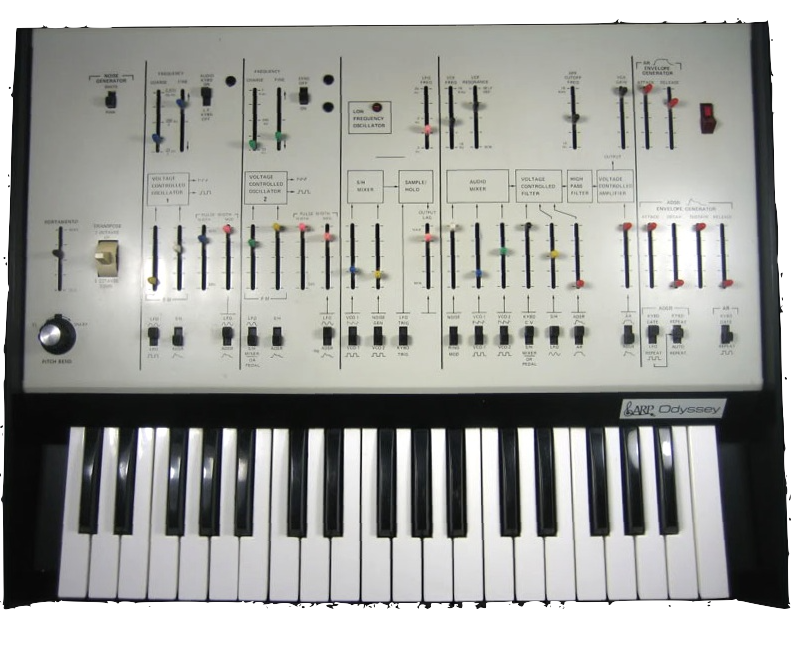 With the Odyssey series there is a confusion until today, concerning the model designations. Quite "wrong" are the designations "Mk I" and "Mk II" - the most secure is "Whiteface", "Black/Golden" and "Black/Orange". Nevertheless, there are still differences even in these three groups.
With the Odyssey series there is a confusion until today, concerning the model designations. Quite "wrong" are the designations "Mk I" and "Mk II" - the most secure is "Whiteface", "Black/Golden" and "Black/Orange". Nevertheless, there are still differences even in these three groups.
The first Odyssey (Model 2800, 1972-74) was called "Whiteface" and is easily recognizable by its white enclosure. It has a 12dB SEM filter and a pitch bending pot. In fact, the last "Whiteface" models were already built with a "Black/Golden" enclosure. However, everything inside was identical.
I was hired as a " Roadie " by the "Frank Zappa Band" in the middle of the 70s. George Duke played the "Whiteface" amongst other instruments there - and this Filter is really enchanting. It makes the Whiteface the most distinguishable among the Odys.
 The 2811 series (1975-77) was equipped with a 24dB Filter and a Pitch-Poti. I have forgotten when exactly the three (bright) "PPC" touch pads were introduced as successors to the pitch pot. These pads were also available for retrofitting, which is why they can also be found in older models.
The 2811 series (1975-77) was equipped with a 24dB Filter and a Pitch-Poti. I have forgotten when exactly the three (bright) "PPC" touch pads were introduced as successors to the pitch pot. These pads were also available for retrofitting, which is why they can also be found in older models.
The Black/Golden era was also associated with two Filter replacements that were caused by court rulings: the first Filter was found to be a Moog copy and had been prohibited. As far as I know, three different sounding filters were in high demand. The first (12dB) was close to the Oberheim SEM, the second Moog (24dB) and the third (4075) original ARP (24dB).
Model 2820-2823 (1978-81)
 The "black / orange case came with some outwardly striking changes: the vinyl bottom section had given way to an all-metal case which is much easier to maintain, as you can pop it up like a hood. The keys now protruded slightly, which in practice caused relatively frequent keyboard injuries. The 2820 no longer appeared as fragile as its predecessors, also the fader caps were a bit bigger. Sound-wise there are hardly any differences, but the technical layout had been improved significantly and more efficiently.
The "black / orange case came with some outwardly striking changes: the vinyl bottom section had given way to an all-metal case which is much easier to maintain, as you can pop it up like a hood. The keys now protruded slightly, which in practice caused relatively frequent keyboard injuries. The 2820 no longer appeared as fragile as its predecessors, also the fader caps were a bit bigger. Sound-wise there are hardly any differences, but the technical layout had been improved significantly and more efficiently.
A clear deterioration, however, was the Keyboard. It was noticeably lighter and more rickety than previous models, and this became even worse with the latest 2823 series!
Thus: for technicians an improvement: more stable, more efficient, more service-friendly. For musicians: almost a shock - the Pratt Read keyboard, technically unchanged, had become a noisy plastic pile. Touring musicians often suffered keyboard damages. Especially the process of putting it in and taking it out of the carrying case was highly dangerous.
Fresh Keyboard Bushings on 2811, 2821 und 2823
The video features the keyboard noises of my three Odys, all in freshly made state - at first the Odyssey 2811, followed by the Odyssey 2821 and Odyssey 2823. I find the mechanical quality differences to be unmistakable. As much as I liked the sound of the 2823, the keyboard was violent, insulting and somehow destroyed my approach to the instrument.
Odyssey Mods
 Since the modifications are hard to imagine, I made a sketch for the Odyssey, limited to the switches and the controls, which show all modifications that I had discussed with Eric (SaintEric.eu).
Since the modifications are hard to imagine, I made a sketch for the Odyssey, limited to the switches and the controls, which show all modifications that I had discussed with Eric (SaintEric.eu).
The multimode SE4109 Filter was in beta phase at that time, but it promised to be a serious highlight, because it represented several different ARP filters at once (according to ARP original designs). Also, the sound and discussions about the new, more advanced VCA made me really excited, because the VCA of the Odyssey is certainly its weak spot. This is audible when compared with the Axxe, which has a VCA with much better "grip".
The SE2607 module (with waveforms from the ARP 2600) is also provided with switches. For extremists it's an option to install two SE2607 (for both VCOs). "Highest/lowest note priority" and "mirror" (for keyboard inversion) were my first requests.
That was really great - when you can say, "I would like to have this / would like the ability to do that..." - and then you get a new switch, pot or in- or output to the Synthesizer with that very function. Also the Odyssey's peculiarity, the 2-octave transposition lever, which is unloved by some, could be replaced with a 1-octave rotary switch thanks to Eric van Baaren.
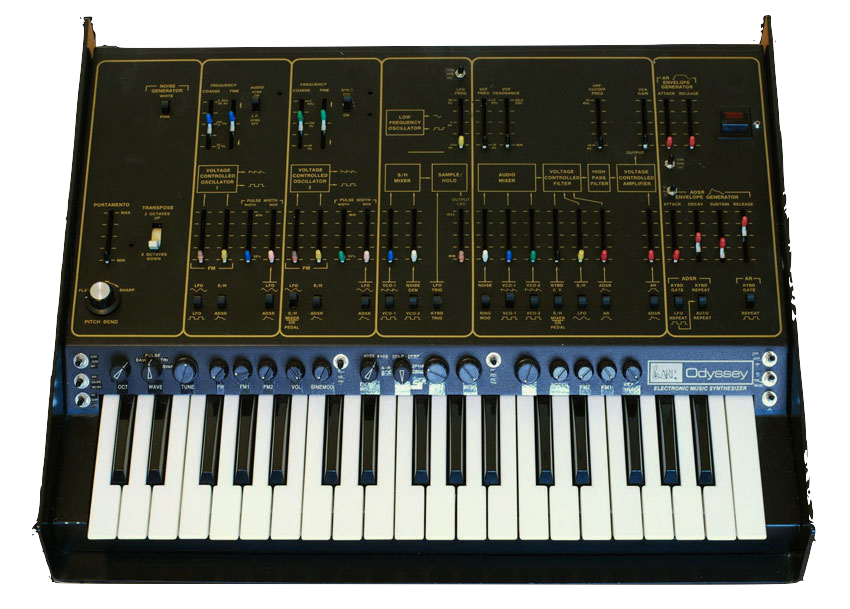 In order to make the Odyssey also suitable for sounds beyond pop music, modifying is a good idea. The mods done on my 2811 (with PPC instead of pitch wheel) are a) Filter and Audiopath upgrade (makes the Odyssey "HiFi"), b) Mono/Duo switch, c) Speed up / slow down the LFO by a factor of 3 (3 switch), d) AR/ADSR Speed with a factor of 10. These mods will make the Odyssey much more capable.
In order to make the Odyssey also suitable for sounds beyond pop music, modifying is a good idea. The mods done on my 2811 (with PPC instead of pitch wheel) are a) Filter and Audiopath upgrade (makes the Odyssey "HiFi"), b) Mono/Duo switch, c) Speed up / slow down the LFO by a factor of 3 (3 switch), d) AR/ADSR Speed with a factor of 10. These mods will make the Odyssey much more capable.
This photo shows "The Norwegian" - an ultra-modified Odyssey built by Eric van Baaren (SaintEric.eu).
Speed comparison 1: normal vs. modded
Envelope Durations and LFO Speed. This modification increases or slows down the speed of the LFO (on my instrument) by three times and the Envelopes by ten times (3-position switches:"/3, Normal, *3" or "/10, Normal, *10")
Speed comparison 2: normal vs. modded
Distinctions in the shaping of faster Envelopes. An LFO example. Percussive sounds get much more expression and can be shaped more specifically, because the entire EG slider control path is now available within the 10x shorter time.
ARP AXXE
The "little ARP" was built from 1975-81. First as MkI (Black/Golden) and later, I think from 1978, as MkII (Black/Orange). A straightforward built instrument with a convincing ARP sound. The Axxe has two oscillators but only one envelope. This makes it suitable for simple structured sounds, like bass or solo sounds. The Axxe is also equipped with an input for external audio signals and can be expanded via this input e.g. by the Little Brother.
From time to time you may read that the Axxe is "weaker" than the Odyssey - this is not true at all - on the contrary! It has a significantly better VCA than the Odyssey! It certainly has one less Envelope and also no Ring-Modulation. Of course therefore it is more simply built and "smaller". But the sound itself is quite more expressive (bigger!) - and probably because of the different VCA it's still very popular today, especially as a bass or solo synthesizer.
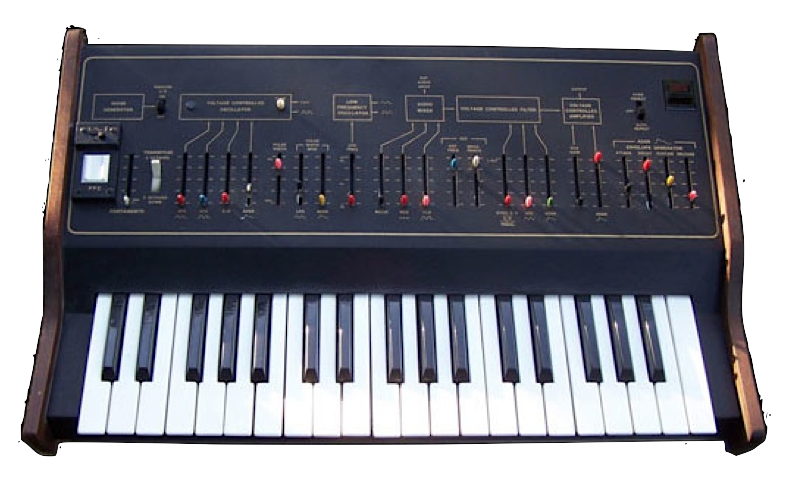
The picture shows my MkI - and for the Axxe series it's okay to talk about MkI (black/golden) and MkII (black/orange). There were only these two different models. Even with the Axxe, I like the "MkI" better. More beautiful, better keyboard (which also rattles less and does not protrude), warmer overall (feel) and also sonically more appealing.
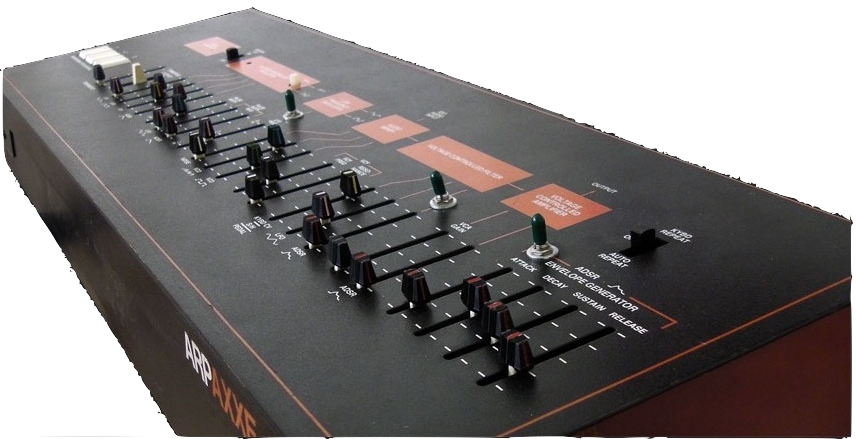 I had transformed my Axxe MkII into an Expander, as I wanted it as an extension for the Odyssey 2821 (see above: Odyssey 2821 & Axxe MkII Expander).
I had transformed my Axxe MkII into an Expander, as I wanted it as an extension for the Odyssey 2821 (see above: Odyssey 2821 & Axxe MkII Expander).
For the implementation of the Expander project I acquired a dirt cheap, terrible looking Axxe with a destroyed keyboard and no functionality at all. The Expander as well received the the required modifications (LFO and ADSR Speed/Duration). In the end it really looked like it came from the factory, but the effort was quite high: original case sawed and bent by a blacksmith, technique overhauled at SaintEric in the Netherlands, new fader knobs from Japan... the cheap price was history. It has been a great project, but I would never recommend it to anyone.
Rather buy an Axxe MkI.
ARP Little Brother
The ARP Little Brother is a monophonic Expander module that serves as a companion to other ARP Synthesizers and was built from 1975 to -77. It is controlled by patching the control voltage outputs (CV, trigger, gate) of an ARP synth's keyboard to the CV inputs of the Little Brother.

The Little Brother is equipped with a single square wave oscillator (VCO) with selectable waveforms and a sub-octave divider that can produce up to three additional tones simultaneously in intervals of -1, -2 and -3 octaves. The waveforms "Brass", "Hollow", "Reed" and "Fuzz" can also be applied simultaneously.
Next to the Volume Slider is the "Effects" block, consisting of an LFO with Speed- and Depth Sliders and a Vibrato-Delay-Switch, which delays the onset of the LFO to a certain extent. The LFO signal is also available as a CV output signal (mini jack) on the rear panel. Finally there is the Pitchbend control, which ranges up and down one octave. The Little Brother has neither Filters (VCF) nor Amplifier (VCA) nor Envelope Generator (EG / ADSR).
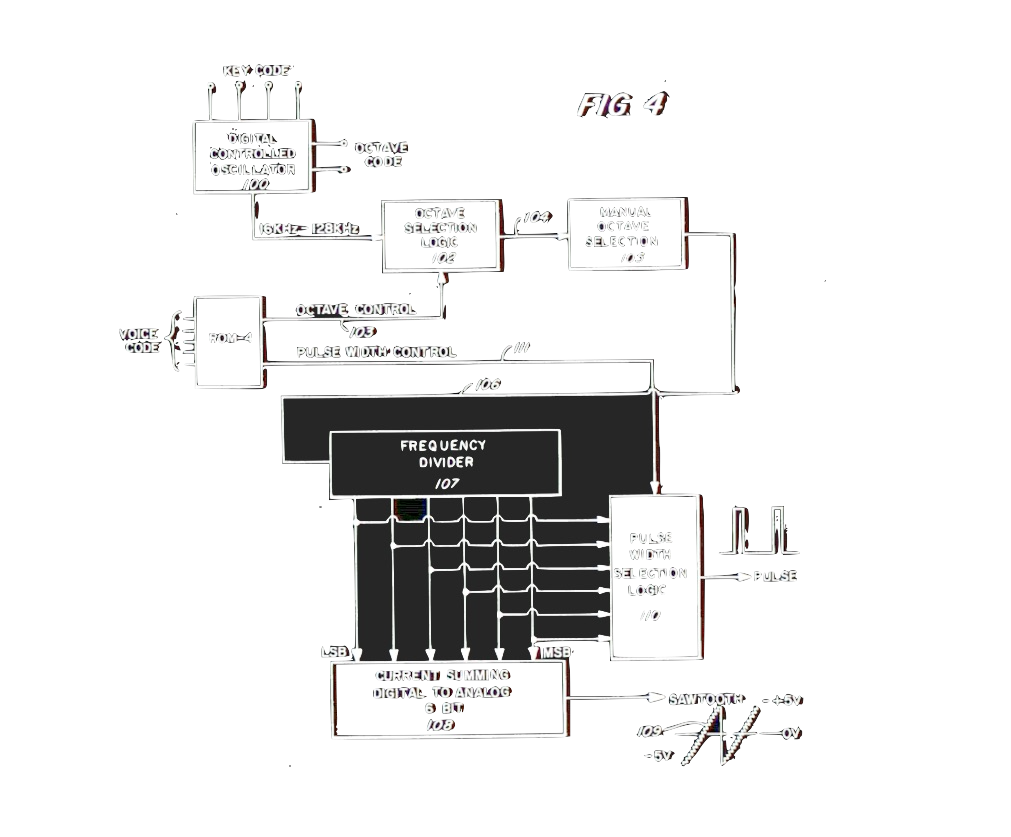 The 8 large white toggle switches are set in the position up = off and down = on. Those switches appeared for the first time on the ARP Pro Soloist (1973). Although the Little Brother looks like a fossil, it was still clearly ahead of its time.
The 8 large white toggle switches are set in the position up = off and down = on. Those switches appeared for the first time on the ARP Pro Soloist (1973). Although the Little Brother looks like a fossil, it was still clearly ahead of its time.
It's just my guess and I'm not a technician, but I think the technology behind these old-fashioned looking toggle switches already worked digitally, because only in this way such a fast and pitch-stable switching became possible - and this technology was built into the "Pro Soloist" for the first time.
If the Little Brother is used together with other ARP synthesizers in order to "fatten up" their sounds, the audio output of the Little Brother must be patched into the external audio input of the Synthesizer, essentially adding an additional VCO and LFO to the system. Pleasantly, the Little Brother also has an audio input. The fact that it sounds "fatter" than Axxe or Odyssey is caused not only by the sub-octave divider, but also by the fact that its circuitry is based on an ARP 2600 Oscillator (15V).
The Little Brother is the last ARP instrument I still own - and it created a problem in this modern (12V) world (for me), because I couldn't create 15V triggers anymore, which ARP requires. Previously, in order to be able to send 15V triggers and CV from the computer, I used to have a Kenton Pro-2000 MkII, which I had sold with the ARPs however - in fact, it would also be oversized for my particular requirements today. But Kenton also builds smaller models and seems to be the only manufacturer of MIDI to CV converters that can also send 15V triggers (and yet they are affordable).
 Well, I have now granted my Little Brother a small (Eurorack) "ARP-to-Modular-2020 extension", which, apart from the Kenton Modular Solo, also contains a Dual Amp from ADDAC. With the Dual Amp I can adjust / increase the signal strength to feed Little Brother into my modular synths (Buchla, MOTM and Eurorack - so up to 12dB audio level). The second amp I use to cut the signals from the Modular for the audio input of the Little Brother. The entries on the picture at Aux2, 3 and 4 (Velocity, ModWheel and Exp. Pedal) are proposals to connect a keyboard - of course other addresses can be selected as well.
Well, I have now granted my Little Brother a small (Eurorack) "ARP-to-Modular-2020 extension", which, apart from the Kenton Modular Solo, also contains a Dual Amp from ADDAC. With the Dual Amp I can adjust / increase the signal strength to feed Little Brother into my modular synths (Buchla, MOTM and Eurorack - so up to 12dB audio level). The second amp I use to cut the signals from the Modular for the audio input of the Little Brother. The entries on the picture at Aux2, 3 and 4 (Velocity, ModWheel and Exp. Pedal) are proposals to connect a keyboard - of course other addresses can be selected as well.
Rhodes Chroma
16 x ARP in one instrument! Manufactured 1982-83. Produced by CBS - after the bankruptcy of the ARP company.

It was my first ARP and my biggest one as well. Actually, the Chroma, developed in 1979-80, was supposed to end the company's financial problems, but the bankruptcy for ARP Instruments occurred in 1981, right before the production of the Chroma would even start. The blueprints (design) for the Chroma were sold to CBS Musical Instruments and the instrument was eventually built by the Rhodes company. After production ceased, some Rhodes Chromas hit the market in 1984 for about a quarter of the original price. So this turned out to be THE chance of getting an original synth, and thus a real basis for figuring out whether synthesizers were "something I was interested in". I was lucky enough to get the money and I received this battleship.
The suggested retail price was $8400, and the Dollar in 1984 was between DM 2.85 and DM 3.15. Adding transportation costs, taxes, and customs fees, that was more than 25,000 DM! That meant "unaffordable" - even with a slightly reduced retail price. Then, in spring 1984, it suddenly "only" cost 6200.- DM (incl.). So seriously: that was a Sensation, and it was THE once-in-a-lifetime opportunity!
Sonically in the realm of the Nonplusultra of its time, cramped with circuit boards and equipped with a 25 pin D-sub computer interface for Apple II (!), for which there was a sequencer program and a cassette interface (for program data). The Chroma has been one of the first microprocessor-controlled Synthesizers. The hardware was equivalent to 16 (fully analog) ARPs, each with a VCO, multimode filter and VCA - the basis for the exuberant variety of sounds. These 16 voices, now called channels, were treated in 8 A/B formations. This had probably - as far as I understand - to do with the CV control voltage, which was transmitted in a multiplex procedure (thus quasi 2 data channels in a data conductor). The envelopes (CV) were generated software-sided! The VCOs had a frequency sampler (with zero-crossing detector) as an "add-on", which made it possible to measure the wavelengths of all VCOs and VCFs ( in order to store them correctly in the preset). This also made the futuristic "Auto-Tune" possible, by the way. With 16 VCO and 16 filter frequencies an enormous help and clear relief for "live" conditions.
 For setting the different parameters of the modules into motion, the microprocessor could generate 32 ADSR envelopes and 16 LFO. That's 1x LFO and 2x ADSR per voice. The second envelope came additionally with delay - as already seen on the ARP 2500. The voices also could work in pairs. The graphic shows 4 of 16 possible interconnections of the channels. If channel A and B were connected in pairs, the Chroma was then "only" 8 voices of polyphony, of course, but the sounds were considerably fatter or more complex. Other ideas from the ARP 2500: the color coding of the membrane knobs and now a microprocessor (which makes the CV connections) instead of the matrix sliders - instead of the patch cords.
For setting the different parameters of the modules into motion, the microprocessor could generate 32 ADSR envelopes and 16 LFO. That's 1x LFO and 2x ADSR per voice. The second envelope came additionally with delay - as already seen on the ARP 2500. The voices also could work in pairs. The graphic shows 4 of 16 possible interconnections of the channels. If channel A and B were connected in pairs, the Chroma was then "only" 8 voices of polyphony, of course, but the sounds were considerably fatter or more complex. Other ideas from the ARP 2500: the color coding of the membrane knobs and now a microprocessor (which makes the CV connections) instead of the matrix sliders - instead of the patch cords.
 However, there were some disadvantages: the enormous weight (with case), the technical vulnerability - many Chromas I saw over time had at least one failed module (that was 2 voices). Another issue was more of a period thing, as computers were just emerging and both knowledge, availability, and required money were among the rarer items. That's why the missing knobs and switches were an issue in the beginning: the Chroma has only 6 sliders: tune, 3x EQ (bass, mids, treble), volume and "parameter control". It is analog, after all, but it has digital control - and there was only that single slider for all parameter values. The parameter to be modulated first had to be assigned to this particular slider, which was done by selecting one of the 50 (out of 71) membrane knobs, which were also used to recall presets when playing. I was soon able to fix the "control problem" to some extent with an EES-Chroma MIDI interface, and then in 1989 Max (software) provided a shift in all limits. The economical panel design of the Chroma with the membrane buttons was later adopted by many companies - also in the Yamaha DX7 (1983). The Rhodes Chroma was truly a behemoth in every respect!
However, there were some disadvantages: the enormous weight (with case), the technical vulnerability - many Chromas I saw over time had at least one failed module (that was 2 voices). Another issue was more of a period thing, as computers were just emerging and both knowledge, availability, and required money were among the rarer items. That's why the missing knobs and switches were an issue in the beginning: the Chroma has only 6 sliders: tune, 3x EQ (bass, mids, treble), volume and "parameter control". It is analog, after all, but it has digital control - and there was only that single slider for all parameter values. The parameter to be modulated first had to be assigned to this particular slider, which was done by selecting one of the 50 (out of 71) membrane knobs, which were also used to recall presets when playing. I was soon able to fix the "control problem" to some extent with an EES-Chroma MIDI interface, and then in 1989 Max (software) provided a shift in all limits. The economical panel design of the Chroma with the membrane buttons was later adopted by many companies - also in the Yamaha DX7 (1983). The Rhodes Chroma was truly a behemoth in every respect!
 The rear of the Chroma was pretty impressive as well, and there were a few new connectors. On the far left is a (silver) small 15-pin D-Sub input that was not included as a standard feature. The synth came prepared, but with a blank mini panel to cover it. I had gotten this plug to connect my EES MIDI interface. Next to it is the big 25-pin D-Sub connector to connect with the Apple II computer. Next, two XLR "Studio Output" (balanced) and beside it the "classic ARP audio outputs "Low- and High Level" (for stage combos available as jacks). The "Dual Footswitch" pedal was pretty good, because it didn't slip off because you had your foot on the floorboard. It was therefore huge - just as deep as the Chroma (see case photo). I have no experience with the Sequence Switch, but the inputs for Volume and Eypression pedal were highly welcome! In the "Audio Inputs/Outputs" was by default the output 3 ( which is also the number of the 2nd XLR Out) as the right output for stereo, but it could be changed to 1,2 or 3. 1-3 were inputs. If you wanted to play the Chroma in stereo, you had to define this previously (link channel). The cassette interface for saving or loading sound banks was state of the art. It sounded like one of the first modems and when loading on stage it was quite stressful, because it sometimes took several attempts until the content was transferred without errors.
The rear of the Chroma was pretty impressive as well, and there were a few new connectors. On the far left is a (silver) small 15-pin D-Sub input that was not included as a standard feature. The synth came prepared, but with a blank mini panel to cover it. I had gotten this plug to connect my EES MIDI interface. Next to it is the big 25-pin D-Sub connector to connect with the Apple II computer. Next, two XLR "Studio Output" (balanced) and beside it the "classic ARP audio outputs "Low- and High Level" (for stage combos available as jacks). The "Dual Footswitch" pedal was pretty good, because it didn't slip off because you had your foot on the floorboard. It was therefore huge - just as deep as the Chroma (see case photo). I have no experience with the Sequence Switch, but the inputs for Volume and Eypression pedal were highly welcome! In the "Audio Inputs/Outputs" was by default the output 3 ( which is also the number of the 2nd XLR Out) as the right output for stereo, but it could be changed to 1,2 or 3. 1-3 were inputs. If you wanted to play the Chroma in stereo, you had to define this previously (link channel). The cassette interface for saving or loading sound banks was state of the art. It sounded like one of the first modems and when loading on stage it was quite stressful, because it sometimes took several attempts until the content was transferred without errors.
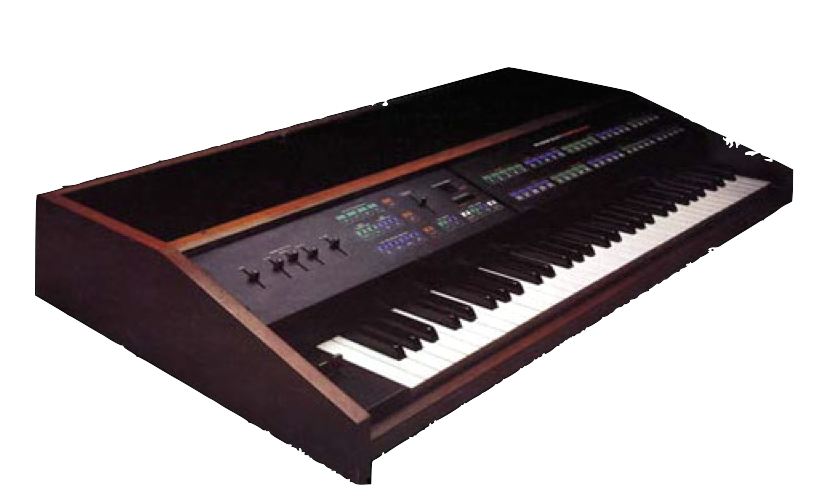
Just three months after receiving the Chroma, I did my first synthesizer production for a drama by Ivan Klima. The Rhodes Chroma was the synth I had the longest. Editing it was a pain (because I didn't have an Apple II computer then), but playing the Chroma was extremely rewarding. Despite the enormous weight, I carried it with me a lot, even outdoors (e.g. in the Alps with a power generator) or at underground concerts, where I might have to escape with all my equipment - but at that time there was still some help from the audience..
Theatre Music 1984
Rhodes Chroma + FX-Pedals. No Guitars und no Sequencers involved
The Rhodes Chroma was available also without keyboard under the name "Expander" - to extend the Rhodes Chroma, but also as a keyboard-less standalone version. In the later years (when MIDI was established) the Expander (alone) became even more popular with many touring musicians than the full version - probably because of the ease of transportation. Yet also the price of the Expander already was one pain level beneath with $ 5200.
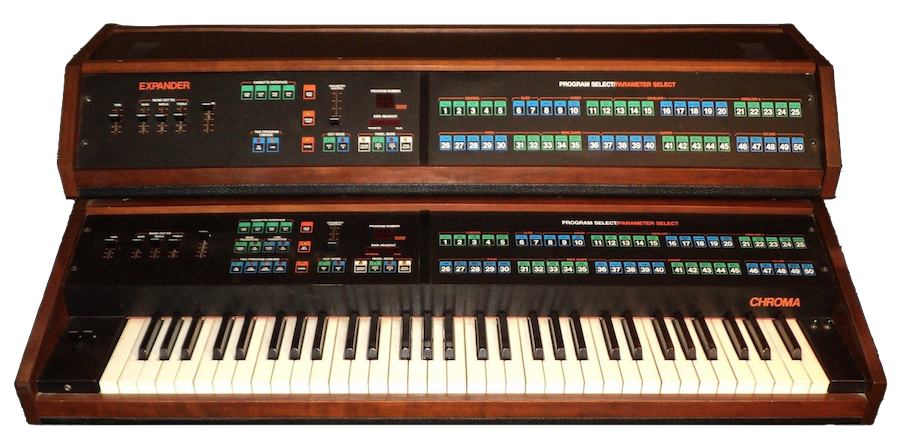
In 1984, my piano teacher at the time, Fritz Pauer, introduced me for piano lessons with Joe Zawinul. However, we hardly ever played the piano, but rather enthusiastically discussed our ARP synthesizers - we both had the ARP 2600 and the Rhodes Chroma. I explained to him that I occasionally inverted the keyboard (i.e. the highest note on the left and the lowest note on the right) and that the resulting melodies sounded like Joe Zawinul. This opened wide the door, and he told me that he actually does it that way too! Even more interesting was his explanation why he plays ARP 2600 and not a MiniMoog:
"When I play Moog and people walk into the concert hall, the first thing that they will hear is 'Moog'. If I am playing the ARP, the first thing they hear is Zawinul!"
Without intending to offend Moog, I find the statement very accurate! ARP is just far more complex or variable to patch than the Mini and has because of the, rather HiFi neutral sound, a much wider sonic spectrum - in contrast to the overdriven and thus by straight harmonics enriched sound of the MiniMoog, which is characteristic and often described as "warm" (in the Mini, the filter is "overdriven" with about 15 dB).
The Chroma has shaped me and what I am doing today with my hybrid modular is nothing different than what the Chroma did - except that I can write the software myself today. Interesting also that the grandmasters Alan R. Pearlman and Don Buchla both previously have developed stuff for NASA.
An excellent and complete website: rhodeschroma.com


